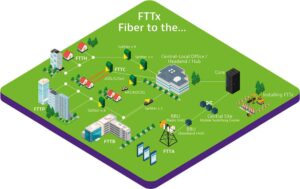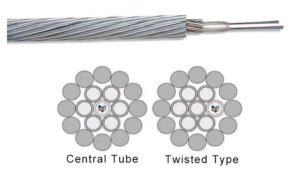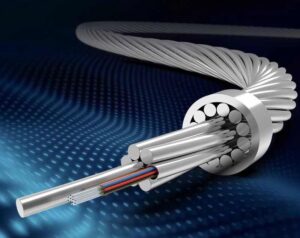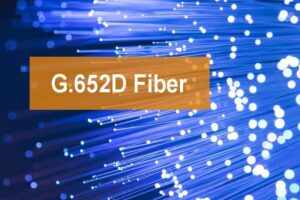FTTx stand for Fiber To The x, where x indicate the destination of the fiber optic link, it is a general term for various fiber optic communication networks. According to the distance of fiber to the home, there are roughly the following types, all services can be collectively referred to as FTTx.
X | = | H=home P=premises C=curb N=node/ neighborhood O=office | A=antenna SA=service area R=room B=building |
Yingda has become China’s most advantageous Fttx solution provider and fiber potic manufacturer with international standard strict quality control, mature supply chain system and refined operation, which ensure the competitive price, high efficiency productivity, timely delivery and telecom standards.
The specific selection of optical fiber products will vary depending on the network architecture (such as FTTH, FTTB, FTTC, etc.)
Singlemode fiber (G.652.D): the most commonly used fiber type, low loss, high bandwidth, suitable for long-distance transmission (such as backbone networks and distribution networks)
Bend-insensitive fiber (G.657.A1/A2/B3): strong bending resistance, suitable for complex wiring in homes and buildings (such as narrow corners, pipes)
Ribbon cable: multiple fibers are arranged side by side into ribbons, suitable for high-density wiring (such as trunk cables or splitter connections).
Indoor and outdoor optical cables:
Outdoor cables: armored structure, moisture-proof and tensile (such as overhead, pipeline, direct burial).
Indoor cables: flame retardant, flexible (such as vertical wiring in buildings).
Drop cable: light and easy to bend, used for home access (FTTH terminal wiring).
Fiber patch cable: short-distance connection between devices (such as OLT-ODF, ONT terminal).
Fiber terminal box: used for fiber optic cable termination and fusion protection (such as wall-mounted, rack-mounted).
Cable junction box: outdoor fiber optic cable splicing protection (waterproof and dustproof).
Fiber splicing sleeve: heat shrink tube or mechanical type, to protect the fusion point.
Fiber optic quick connector (mechnical connector): no need for fusion splicer, fast termination on site (suitable for leather cable).
Fiber optic attenuator: adjust optical power (such as to avoid ONT receiving overload).
Fiber optic detection tools: OTDR (fault location), optical power meter, red light pen, fiber optic cleaning pen, etc.
The core of FTTx network is low cost and high reliability, so optical fiber products need to take into account both performance and construction convenience, especially the home access part often uses prefabricated termination or field cold connection technology to reduce the difficulty of deployment. The entire link is mainly divided into three sections:
The following are typical application cases of FTTx (Fiber to the x) in the world and China, covering different technical models (such as FTTH, FTTB, FTTC) and operator practices:
(1) Zhejiang Mobile: Government-enterprise integration services and full-process automation
Model: FTTB+LAN (fiber to the building) and FTTH (fiber to the home) hybrid deployment.
Highlights: GPON technology is used to achieve the integration of IMS fixed-line and broadband services, and unified Centrex and other government-enterprise services are superimposed (such as short number inter-dialing and switchboard functions). The fixed-line BOSS system realizes full-process automation, including port activation and construction dispatching.
(2) Jiangsu Mobile: EPON technology pilot
Model: FTTX solution based on EPON, covering business halls, commercial buildings and high-value customers. Provides 1Gbps bandwidth and supports services such as HD IPTV and TDM dedicated lines. The solution provided by FiberHome Communications has automatic fault detection and QoS guarantee functions.
(3) Henan Tietong: GPON network transformation
Model: GPON+FTTH is preferred to transform existing cable communities (such as Zhengzhou Yangguang Jiayuan). Solve the problem of existing market competition and increase user bandwidth to more than 20M.
(4) Shanghai Telecom’s “City Optical Network” plan
Model: EPON+FTTH, covering the Expo Park and the entire city. Achieve “100M to the home, 1000M to the building”, ZTE provides technical support, and supports IPv6, Blu-ray IPTV and other services.
(1) Telecom Italia (TI)
Model: Huawei provides FTTB/FTTH solutions, covering 120,000 users. Deploys Huawei SmartAX OLT and ONT equipment to support triple play (Internet, voice, video).
(2) Romania Telecom (Romtelecom)
Model: GPON+FTTB as the main, FTTH as the auxiliary. Utilizes existing copper wire resources to quickly deploy VDSL2 network, covering 400,000 users, and seizes the high-end market.
(3) ENTEL, Bolivia
Model: ZTE built the largest FTTx network in China based on GPON technology. Using the ZXA10 C300 platform, it supports future NG PON upgrades and narrows the digital divide.
(4) Kunming Telecom Xiaolingtong Transformation
Model: Huawei FTTx+EPON carries Xiaolingtong base stations. Through ONU transparent transmission of ISDN interfaces, 350,000 Xiaolingtong users are smoothly migrated.
FTTx application cases show that GPON/EPON technology is the mainstream, and the deployment model needs to be combined with the scenario (such as FTTB is suitable for high-density areas, and FTTH is for high-end users). Operators achieve rapid coverage and cost optimization through automated processes (such as Zhejiang Mobile) and hybrid network construction (such as Romania).
FTTH is one access methods of FTTx network, h means home. X can be home, premises, curb, desk, node or building, etc.
FTTH is fiber optic access to households. Users can directly access the network through fiber, and the indoor optical modem converts the signal to the user's Internet device to use telephone, telecommunications, IPTV and other services; FTTB is an optical cable to the corridor or to the large optical modem in the building. When the user installs the equipment, the network cable is used to connect the large modem device to the user's indoor Internet device, so the network cable is finally brought into the home.
GPON is one of the key technologies to realize FTTH, and FTTH is a typical application of GPON technology in high-quality access scenarios. The two work together to build the core framework of modern fiber-optic broadband networks.
According to current technological evolution and market demand, FTTH (fiber to the home) is still the optimal solution in the field of broadband access and may long-lasting 10 more years, but it also faces challenges from technological iteration and emerging models.
You can find it easily by check your ONU ONT, if there is mark “ONT”or “fiber access” and with optical signal indicator? If use ADSL modem or router, it is not fiber.
Also fiber interface is SC or LC connectors, if your port is RJ11 or RJ45 interface, it is network not fiber.
By optimizing and reusing infrastructure, upgrading facility technology solutions and intelligent operation and maintenance engineering management, unifying standardized systems and integrating supply chains to achieve economies of scale, and innovating service models, the deployment cost of FTTX can be significantly reduced.







Sorry that there’s no information that interests you. Please fill in the feedback form so that we can improve.